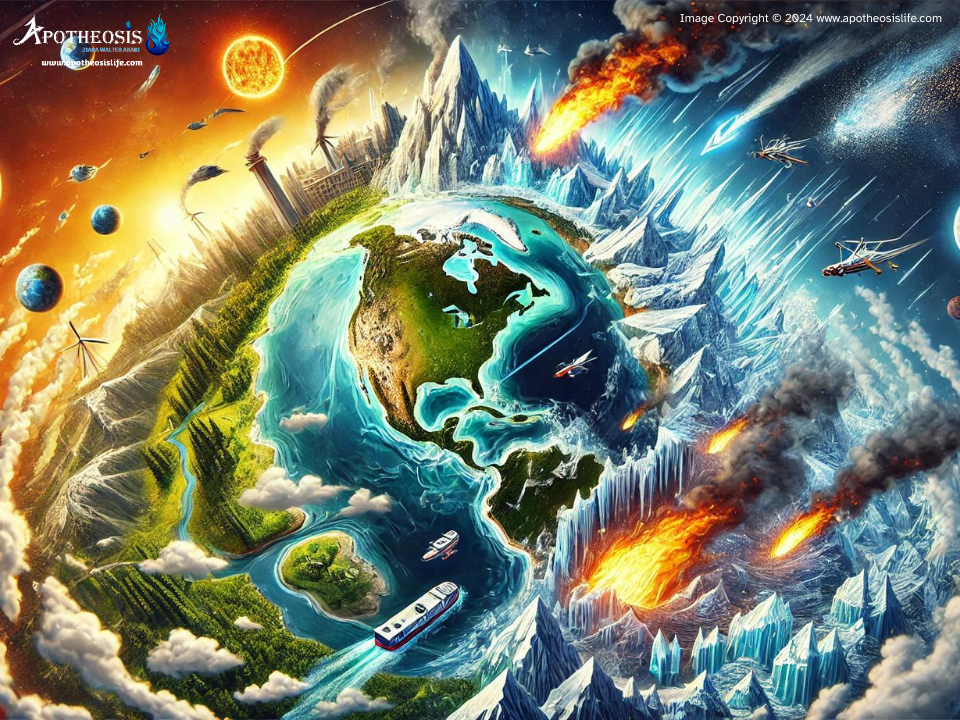Climate change is a pressing global issue, and within this context, the concept of tipping points has gained significant attention. Tipping points refer to critical thresholds in the Earth’s climate system that, once crossed, can lead to drastic and often irreversible changes. This article explores the science behind climate tipping points, their potential impacts, and the urgency of taking proactive measures to prevent crossing these critical thresholds.
Understanding Tipping Points
A tipping point in the climate system occurs when a small change in external conditions causes a large and often abrupt change in the system’s state. These points are typically associated with feedback loops that amplify initial changes, leading to significant and sometimes catastrophic outcomes.
Examples of Climate Tipping Points
Melting of Polar Ice Sheets
Greenland Ice Sheet: The melting of the Greenland ice sheet could lead to a significant rise in sea levels. If the ice sheet melts entirely, it could contribute up to 7 meters (23 feet) to global sea levels, drastically altering coastlines worldwide.
Antarctic Ice Sheet: Similarly, the West Antarctic ice sheet is at risk of collapsing, which would result in a substantial rise in sea levels and severe impacts on global ocean circulation patterns.
Arctic Sea Ice Loss
The Arctic sea ice is rapidly diminishing due to rising temperatures. The loss of sea ice reduces the Earth’s albedo (reflectivity), causing more solar radiation to be absorbed by the ocean, further accelerating warming and ice melt.
Amazon Rainforest Dieback
The Amazon rainforest, often referred to as the planet’s lungs, is experiencing increased deforestation and drought. These stressors could push the rainforest past a tipping point where it transitions from a carbon sink to a carbon source, exacerbating global warming.
Thawing Permafrost
Permafrost in the Arctic regions contains vast amounts of stored carbon in the form of methane and CO2. Thawing permafrost releases these greenhouse gases, creating a feedback loop that accelerates global warming.
Coral Reef Collapse
Coral reefs are highly sensitive to temperature changes. Rising sea temperatures can cause coral bleaching and eventual die-off, leading to the collapse of entire reef ecosystems, which are crucial for marine biodiversity and coastal protection.

Image Source: www.earth.org
The Impact of Crossing Tipping Points
Crossing climate tipping points can have profound and far-reaching impacts on the environment, human societies, and global economies. These impacts include:
Sea Level Rise
Melting ice sheets and glaciers contribute to rising sea levels, threatening coastal communities, infrastructure, and ecosystems. This can lead to displacement of populations and loss of biodiversity.
Extreme Weather Events
Changes in the climate system can increase the frequency and intensity of extreme weather events such as hurricanes, droughts, and heatwaves. These events can cause widespread damage and exacerbate humanitarian crises.
Loss of Biodiversity
Ecosystems like coral reefs and rainforests are vital for biodiversity. Their collapse can lead to the extinction of numerous species and the disruption of ecosystem services that humans rely on.
Preventing Tipping Points
Preventing tipping points requires urgent and coordinated global action to mitigate climate change. Key strategies include:
Reducing Greenhouse Gas Emissions
Rapidly reducing emissions by transitioning to renewable energy sources, improving energy efficiency, and implementing carbon capture and storage technologies is crucial.
Protecting and Restoring Ecosystems
Efforts to conserve and restore critical ecosystems like rainforests and coral reefs can enhance their resilience to climate change and prevent tipping points.
Promoting Sustainable Land Use
Sustainable agricultural and forestry practices can reduce deforestation and land degradation, preserving carbon sinks and biodiversity.
International Cooperation
Global agreements like the Paris Agreement are essential for coordinating climate action and ensuring that all countries contribute to mitigation and adaptation efforts.
Understanding and addressing climate tipping points is critical for ensuring a sustainable future. By taking proactive measures to reduce greenhouse gas emissions and protect vulnerable ecosystems, we can prevent crossing these dangerous thresholds and mitigate the worst impacts of climate change. As the urgency of climate action grows, it is imperative that individuals, communities, and nations work together to safeguard our planet.
Details of the Featured Image
Illustrating the precarious balance of Earth’s climate, this image highlights the critical tipping points we face, from melting ice caps to extreme weather events.
Image Copyright © 2024 www.apotheosislife.com
Author
Ziara Walter Akari
© www.apotheosislife.com
